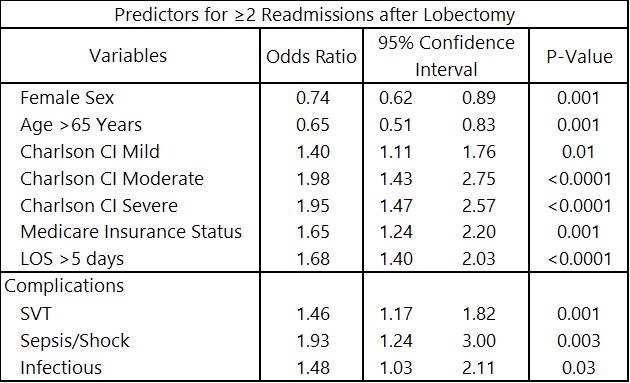Identifying Drivers of Multiple Readmissions Following Pulmonary Lobectomy
Raymond A Jean1, *Alexander S Chiu1, *Justin D Blasberg1, *Daniel J Boffa1, *Frank C Detterbeck1, Anthony W Kim2
1Yale School of Medicine, New Haven, CT;2Keck School of Medicine of USC, Los Angeles, CA
Objective: To identify the prognostic factors and characterize the differences that drive multiple readmissions following pulmonary lobectomy.
Design: Retrospective cohort study
Setting: Patients admitted to acute-care hospitals across the United States between 2013 and 2014.
Patients: The Nationwide Readmissions Database, a nationally-representative stratified cluster sample, was queried for patients with a primary diagnosis of lung cancer who underwent open, robotic (RobATS), or thoracoscopic (VATS) lobectomy.
Intervention(s): None
Main Outcome Measure(s): Primary outcome was all-cause readmission within 90 days from discharge after hospitalization for pulmonary lobectomy.
Results: Of the 42,514 lobectomies during the study period, 7352 patients (17.3%) were readmitted. Among this group, 1554 patients (21.1%) had ≥2 readmissions, with those undergoing RobATS having a significantly higher rate of ≥2 readmissions (RobATS 27.5% vs Open 20.8% and VATS 19.8%, p=0.03). After adjustment for other clinical and demographic factors, postoperative dysrhythmia (OR 1.46 95% CI [1.17, 1.82], p=0.001), postoperative infection (OR 1.48, 95% CI [1.03, 2.11], p=0.03) and postoperative sepsis (OR 1.93 95% CI [1.24, 3.00], p=0.003) during the index hospitalization were associated with an increased risk of ≥2 readmissions. Among second readmissions, the most frequent diagnostic categories were arrhythmia/cardiac disease (173, 11.1%), pleural effusion or empyema (144, 9.3%), and sepsis (137, 8.8%).
Conclusions: RobATS had a significantly higher rate of multiple readmissions within 90 days, compared to other approaches. Dysrhythmias, infection, and sepsis during the initial lobectomy hospital stay were prognostic for multiple readmissions. Further investigation is warranted into the etiology behind multiple postoperative readmissions.

Back to 2017 Program
